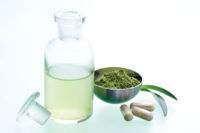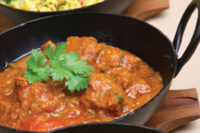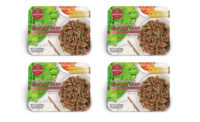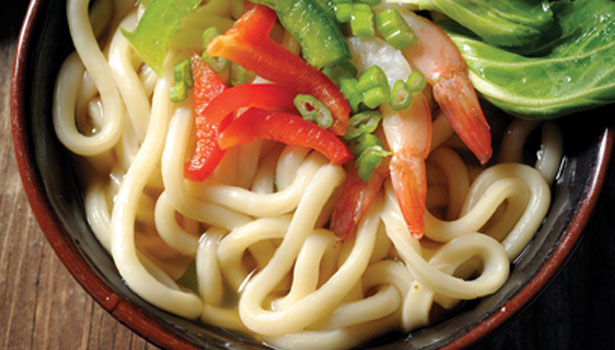Korean Cuisine: More than Rice, Soy and Chilies




Korean food stands out from other cuisines with the many side dishes, or banchan, which are served during meals. The number of these can range anywhere from two to a dozen or more. Everyday meals always feature at least a few.
Koreans perfected the art of preserving food over thousands of years, so many of their most common side dishes rely on fermentation, pickling or salting for flavor and preservation, to produce a tangy, salty and spicy taste. One of the most notable of these is kimchi, Korea’s famous spicy cabbage. There are hundreds of varieties of kimchi, each featuring different combinations of vegetables. It can be served with any meal at any time.
Rice is the backbone of almost every Korean meal. However, this has not always been the case. The grain is not indigenous to Korea. When it first came to the peninsula, rice was prohibitively expensive, so it was likely mixed with other grains to stretch it. This is still done in dishes such as boribap (rice with barley) and kongbap (rice with beans). Also, noodles can replace rice in some recipes.
Today, rice is used to make a number of dishes not limited to the traditional bowl of plain white rice. It is commonly ground into flour to make one of the 200 varieties of rice cakes called tteok. It can also be cooked down into a congee (juk) or gruel (mieum) and mixed with other grains, meat or seafood. Korea also produces a number of rice wines.
Each meal traditionally includes soup or stew served as part of the main course, rather than at the beginning or the end of the meal. Soups known as guk are often made with meats, shellfish and vegetables. Soups can be turned into more formal soups, known as tang, often served as the main dish of the meal.
Jjigae is a thicker, heavier seasoned soup, while malgeunguk is flavored with spicy ganjang, a variety of Korean soy sauce. Small amounts of tender boiled meat or fresh and dried seafood may be added to the soup, and vegetables may be the main component for the clear soup. Tojang guk are seasoned with doenjang, a fermented bean paste. Common ingredients for tojang guk include seafood, such as clams, dried anchovies and shrimp.
Naengguk are cold soups usually seasoned with ganjang and sesame oil. Stews are often shared as side dishes. Doenjang jjigae is a stew of soybean paste and comes in many variations. Some common ingredients include vegetables, salt or freshwater fish, and tofu.
Condiments are divided into two groups: fermented and non-fermented. Fermented condiments include ganjang, doenjang, gochujang (fermented red chili paste) and vinegars. Non-fermented condiments and spices include red pepper, black pepper, Chinese pepper, cordifolia, mustard, chinensis, garlic, onion, ginger, leeks and scallions. Widely used flavorings include garlic, ginger, soy sauce, soybean paste, rice vinegar, sesame oil and chili—often in the form of a paste.
Grains have long been one of the most important staples to the Korean diet. Early on, grains such as barley and millet were mainly grown, supplemented by wheat, sorghum and buckwheat.
Noodles are often featured on Korean menus. Noodles or noodle dishes in Korean cuisine are collectively referred to as guksu. Jajangmyeon is a staple noodle dish extremely popular in Korea as fast, take-out food. It is made with a black bean sauce, diced pork or seafood and a variety of vegetables, including zucchini and potatoes and fried noodles. Kongguksu is a cold noodle dish with a broth made from ground soy beans.
Soy is also made into a tofu, which the Koreans call dubu. Soybean sprouts are sautéed as a vegetable, and whole soybeans are seasoned and served as a side dish. Kongbiji is a by-product of soy milk production and used to thicken stews. Soybeans may also be one of the ingredients in kongbap, which boils together several types of beans and other grains. Soybeans are the primary ingredient in making the fermented condiments called jang. These include the soybean pastes, doenjang and cheonggukjang; ganjang; chili pepper paste (or gochjang); and others.
Bindaetteok, a type of pancake, is a popular snack made with ground mung beans and fresh mung bean sprouts. Starch from ground mung beans is used to make dangmyeon—cellophane noodles. The noodles can be the main ingredient for japchae, a dish associated with festivals and special occasions throughout Korea. Mung bean starch is also used to make jelly-like foods, such as nokdumuk and hwangpomuk. Muks are rather bland, so they are served seasoned with soy sauce, sesame oil and crumbled seaweeds, as well as other seasonings.
In Korea, beef only became common table fare in the latter part of the 20th century. Today one finds beef roasted, grilled or boiling in soups. Beef is also dried into jerky. Budae jjigae is a spicy stew that uses inexpensive meats, such as sausage and Spam, which originated during the Korean War.
Chicken is often served roasted or braised with vegetables, as well as in soups. Koreans use all parts of the chicken, including the gizzard, liver and feet. Young chickens are braised with ginseng and other ingredients. Chicken feet are often roasted and covered with hot-and-spicy sauce and served as a side dish. Samgyeopsal pork (sliced pork belly) is another important protein for the Korean table.
Turning to the sea, fish and shellfish are a major part of Korean fare due to the vast shoreline the peninsula shares with the ocean. Freshwater fish are also popular. Both types of fish are served raw, grilled, broiled, dried or in soups and stews. Common grilled fish include mackerel, hairtail, croaker and Pacific herring. Fish can also be grilled either whole or in fillets. Fish is often dried. These commonly include yellow corvina, anchovies and croaker. Dried anchovies, along with kelp, often form the basis of common soup stocks. Smaller fish, shrimp, squid, mollusks and the like are salted and fermented as jeotgal. The term hoe originally referred to any kind of raw dish. Most often the dish is dipped in gochjang with wasabi and served with lettuce or perilla leaves.
Raw oysters and other seafood can be combined with kimchi to vary the flavor. Salted baby shrimp are used as a seasoning agent, known as saeujeot, to enhance some types of kimchi. Large shrimp are often grilled as daeha gui (grilled white shrimp) or dried, mixed with vegetables and served with rice. Korean cuisine includes octopus, cuttlefish and squid.
Korean cooking uses a wide variety of vegetables, which are often served raw, either in salads or pickles, as well as cooked in various stews, stir-fried dishes and the like. Common vegetables include Korean radish, Napa cabbage, cucumber, potato, sweet potato, spinach, scallions, garlic, chili peppers, seaweed, zucchini, mushrooms and lotus root. Medicinal herbs, such as ginseng, reishi, wolfberry (more popularly known as goji berries), Codonopsis pilosula and Angelica sinensis, are often used as ingredients in cooking.
Grilled dishes are called gui and usually have meat or fish as the primary ingredient, but may also simply be comprised of grilled vegetables. At traditional restaurants, meats are cooked at the center of the table over a charcoal grill, surrounded by various banchan and individual rice bowls. The cooked meat is then cut into small pieces and wrapped with fresh lettuce leaves, with rice, thinly sliced garlic, ssamjang (miso-chili-onion paste) and other seasonings.
Jjim and seon are generic terms referring to steamed or boiled dishes. However, the former is made with meat or seafood-based ingredients marinated in gochujang or ganjang, while the latter is made with vegetables stuffed with fillings.
Bindaeddeok jeon is a savory pancake made with various ingredients. Chopped kimchi or seafood can be mixed into a wheat flour-based batter and then sautéed. They are usually dipped in a mixture of soy sauce, vinegar and red pepper.
All Korean traditional nonalcoholic beverages are referred to as eumcheong or eumcheongnyu, which literally means “clear beverages.” Tea, or cha, refers to various types of tisane (herbal infusions) that can be served hot or cold. They are made from such sources as fruits, flowers, leaves, roots, grains, herbs, and even ingredients such as ginseng and ginger.
Soju is the best known liquor in Korea, but there are more than 100 different alcoholic beverages, including beers, rice and fruit wines, and various liquors. The top-selling domestic beers are lagers, which differ from Western beers in that they are brewed from rice, instead of barley. As a result, Korean beers are lighter and sweeter compared to those produced in the U.S.
As South Korea continues to play an increasing role in global business and economics, there are sure to be more culinary discoveries making their way to the North American table from this intriguing peninsula.
|
Korean Delights Some Typical Korean Menu Items Might Include: |
|
Appetizer Jin Mandoo: steamed dumplings Goon Mandoo: deep-fried dumpings Odang: odang in soup Haemool Pajun: pancake with seafood Ojingoh Saewoo Teekim: squid & shrimp tempura Large Stew Haemool Jungol: assorted seafood, vegetable & noodle in special broth with spicy sauce Hookyumsoh Jungol: shredded black goat & vegetable in special broth with spicy sauce Budae Jungol: sausage, ham, vegetable & noodle in special broth with spicy chili sauce Gopchang Jungol: beef tripe, vegetable & noodle in special broth with spicy sauce Fish Barbeque Jangoh Gui: broiled, eaten with special chili sauce Yeonoh Gui: broiled salmon Kongohi Gui: broiled mackerel pike Choki Gui: broiled cracker Galbi: marinated prime beef short ribs Bulgogi: marinated sliced boneless tender beef Samgyubsal: unseasoned sliced pork brisket Jaeyuk Bokum: sliced boneless tender pork marinated with special sauce Doobu Kimchi Bokum: sauteed pork & kimchi with tofu Ojingoh Bokum: sauteed squid & vegetable with spicy sauce Nakji Bokum: sauteed octopus & vegetable with spicy sauce Agu Chim: steamed monk fish with bean sprouts and spicy sauce Tang Soo Youk: fried pork with special sauce Bosam: unseasoned sliced pork & vegetable with special spicy sauce Japchae: assorted vegetable & beef with clear noodle Small Stew Daegu Tang: silver codfish & radish with spicy sauce in soup Daegu Jiri: silver codfish in soup Agutang: monk fish in spicy soup Al Tang: fluke roe in spicy soup Samyae Tang: chick morrow broth soup Haemool Dwenjang Jigae: soybean paste soup with assorted seafood Haemool Soondoobu Jigae: sillky tofu soup with assorted seafood (hot or mild) Kimchi Jigae: spicy kimchi soup with pork Mandoo Kook: beef dumpling in soup Duk Kook: sliced rice cake in soup Duk Mandoo Kook: beef dumpling & sliced rice cake in soup Haejang Kook: beef rib broth with assorted vegetable soup Soondae Kook: beef rib broth with soondae & assorted vegetable soup Yukgae Jang: spicy beef broth with shredded beef, assorted vegetables and noodle soup Seolrong Tang: beef marrow broth Noodle Dishes Jambong: assorted seafood & vegetables with noodles in spicy soup Jajangmyun: assorted vegetables & pork with noodles in special sauce Samsun Jajang: assorted seafood & vegetables with noodles in special sauce Mool Nangmyun: sliced beef & vegetables with buckwheat noodles in cold beef broth Bibim Nangmyun: cold buckwheat noodles with vegetables & spicy sauce Hae Nangmyun: sashimi, vegetable & buckwheat noodles with spicy sauce Woodong: wheat noodles in soup Sari: wheat noodles |
|
Building Better Korean Noodles: Next Generation |
|
“Fast Korean noodles” is becoming a popular consumer item, similar to the Chinese ramen of a generation ago. The basic ingredients of Korean instant noodles are flour, water, salt, alkaline salts and modified starch. For manufacturers, flour protein and ash content, salt and alkaline salts (carbonates) all play an important role in determining the color and texture of the noodle. “Starches and their derivatives are added into instant noodle formula to improve steaming and cooking quality due to reduced gelatinization temperature,” says Jenny Zhou, food scientist. Korean instant noodles are typically a bright white or yellow, but have a less of an al denté quality, being more chewy and elastic with a very smooth mouthfeel. All of these qualities require a medium protein flour with strong starch, according to Zhou. Citing extensive research on the effects of phosphates on the quality of Korean instant noodles, Zhou notes that up to one third of the modified starch in a typical Korean instant noodle formula could be replaced with a small amount of sodium-potassium-phosphate blend without compromising the product quality, providing cost savings and improving the consistency of the finished product. pf |
Looking for a reprint of this article?
From high-res PDFs to custom plaques, order your copy today!









